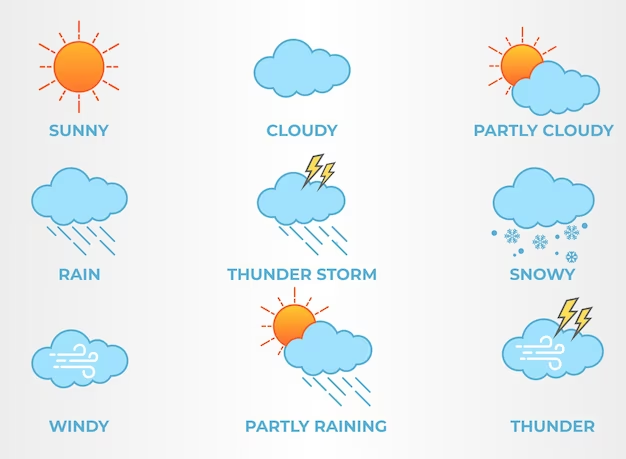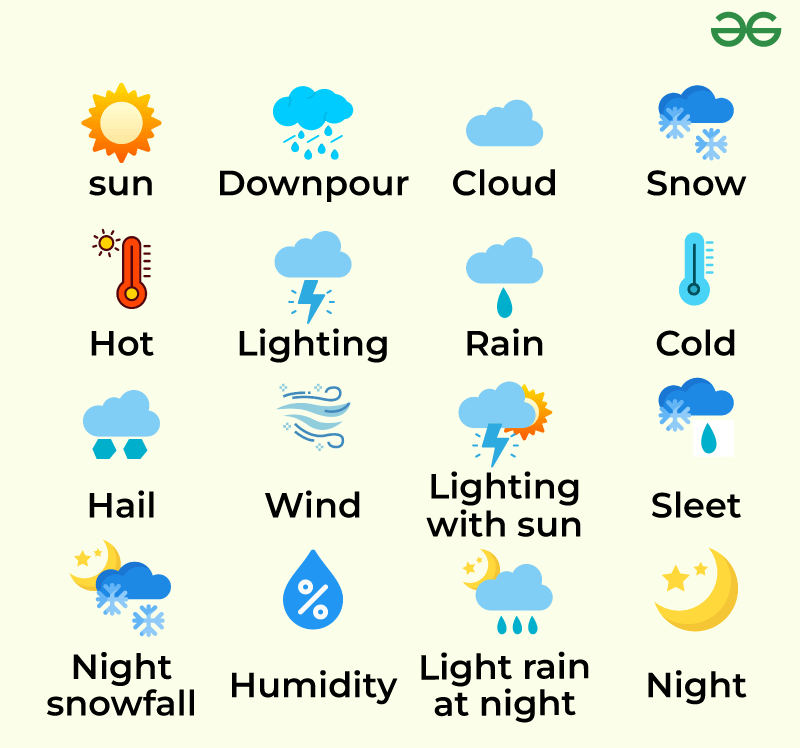- Class: Primary 6
- Term: 1st Term
- Week: 7
- Age: 11 years
- Duration: 40 minutes
- Subject: Basic Science And Technology
- Curriculum Theme: Basic Science
- Previous Lesson: Earth Movement: The Eclipse
- Topic: Changes In Our Climate
- Content: Meaning of Weather, Simple Weather Symbols (Weather Factors)
Performance Objectives:
By the end of the lesson, pupils should be able to:
- Cognitive Domain: Explain the meaning of weather and identify at least three simple weather symbols.
- Affective Domain: Show interest in discussing how weather conditions affect their daily activities.
- Psychomotor Domain: Draw and label at least two simple weather symbols.
- Social Domain: Work in groups to compare and contrast different weather conditions.
Reference Materials:
The following resources were used in planning this lesson:
- 9 – Years Basic Education Curriculum
- Abuja Educational Resource Centre Scheme of Work
- NAPPS National Unified Scheme of Work
- Online Information from Merriam-Webster – Weather Definition & Meaning
- Relevant Textbooks
- Online Information From (https://www.merriam-webster.com/dictionary/weather)
- Online Information From (https://www.geeksforgeeks.org/which-metereological-symbols-are-use-to-mark-weather-maps/)
Instructional Materials:
The teacher will teach this lesson with the aid of:
- Weather charts showing different weather symbols
- Flashcards with weather symbols
- Drawing materials (paper, pencils, erasers)
- Interactive whiteboard for displaying weather images
Rationale for the Lesson:
Understanding the changes in our climate and the concept of weather and recognizing weather symbols are fundamental for pupils as they help them make informed decisions about their daily activities. This lesson also enhances their awareness of environmental changes and prepares them to respond appropriately to different weather conditions.
Prerequisite/Previous Knowledge:
Pupils have previously learned about the Earth’s movement and the eclipse, which gives them a foundational understanding of how changes in the environment occur.
INSTRUCTIONAL PROCEDURES:
Learning Area: Changes In Our Climate
To deliver this lesson, the teacher will adopt the following steps:
| Content Development | Time | Teaching Method | Teaching Strategy | Teacher’s Activity | Pupils’ Activity | Learning Point |
|---|---|---|---|---|---|---|
| Step 1: Introduction | 5 mins | Discussion | Questioning | The teacher starts by asking pupils about their experiences with different weather conditions (e.g., sunny days, rainy days). | Pupils share their experiences with weather conditions. | Engaging pupils’ prior knowledge and curiosity about the topic. |
| Step 2: Meaning of Weather | 10 mins | Explanation | Visual Aids | The teacher explains the meaning of weather, highlighting that it refers to the condition of the atmosphere at a particular time and place. | Pupils listen and take notes on the explanation of weather. | Pupils understand what weather means. |
| Step 3: Simple Weather Symbols | 8 mins | Demonstration | Interactive | The teacher displays and explains simple weather symbols, such as the sun, clouds, rain, and wind. | Pupils observe the symbols and ask questions where necessary. | Pupils identify and understand basic weather symbols. |
| Step 4: Comparison of Weather Conditions | 7 mins | Group Work | Collaborative Learning | The teacher divides the class into groups to compare and contrast different weather conditions using weather symbols. | Pupils work in groups, discussing and comparing different weather conditions. | Pupils develop teamwork and critical thinking skills. |
| Step 5: Note Taking | 5 mins | Explanation | Direct Instruction | The teacher guides pupils in taking notes on the key points discussed so far. | Pupils copy the notes in their exercise books. | Pupils reinforce their understanding through note-taking. |
| Step 6: Evaluation | 3 mins | Oral Questioning | Assessment | The teacher asks the pupils questions to assess their understanding of the lesson. | Pupils answer questions based on what they have learned. | Pupils demonstrate their comprehension of the topic. |
| Step 7: Conclusion | 2 mins | Summary | Recap | The teacher summarizes the lesson, emphasizing the importance of understanding weather and its symbols. | Pupils listen to the summary and ask any remaining questions. | Pupils have a clear understanding of the topic. |
Lesson Content
Changes In Our Climate: Meaning Of Weather, Simple Weather Symbols
Weather is the condition of the atmosphere at a particular time and place. This means that weather can change from one moment to the next. For example, it could be sunny in the morning and rainy in the afternoon.
Simple Weather Symbols
Weather symbols are visual representations used to show different weather conditions, like sunshine, rain, or clouds. They make it easy to understand weather forecasts and help us know what to expect.
- Sun Symbol: Sunny weather.
- Cloud with Raindrops Symbol: Rainy conditions.
- Cloud Symbol: Cloudy weather.
- Snowflake Symbol: Snowy weather.
- Wind Symbol: Windy conditions.
- Fog Symbol: Foggy weather.
- Thermometer Symbol: Temperature levels.
- Lightning Symbol: Stormy or thunderstorm conditions.
- Umbrella Symbol: Shows that rain is expected.
- Hail Symbol: Hailstorms or falling hail.
- Humidity Symbol: High moisture levels in the air


Weather Comparisons:
- Sunny Day: Bright and warm.
- Rainy Day: Darker and cooler.
- Cloudy Day: Overcast but not necessarily rainy.
- Snowy Day: Cold and covered in snow.
- Windy Day: Breezy with moving air.
- Foggy Day: Low visibility with thick fog.
Why Weather Changes:
Weather varies from place to place because of factors such as:
- Location: Weather varies by location due to differences in temperature, humidity, and wind patterns.
- Time of Day: Weather can change from morning to afternoon due to the sun’s position and heating effects.
- Seasonal Changes: Different seasons bring different weather patterns, such as warmer temperatures in summer and colder conditions in winter.
- Geography: Mountains, valleys, and bodies of water can affect local weather conditions by influencing wind patterns and temperatures.
Lesson Evaluation:
To evaluate the learning, the teacher asks pupils to:
- Work in groups to compare sunny and rainy weather conditions.
- Define weather.
- Identify and draw two simple weather symbols.
- Describe how weather conditions can change in a single day.

